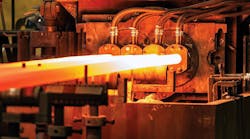ISO 9001:2008 is the latest version of ISO Quality Management Systems Standard, having evolved from the original 1987 version, and subsequent revisions in 1994 and 2000. This standard focuses on Process Approach and Continuous Improvement of and organization’s processes. Several thousand foundries are certified to ISO 9001:2008 all over the world and as such they must be focusing on continuous improvement their metalcasting processes.
However, foundries appear not to have understood how to have their processes operate in optimal condition using continuous improvement methods. This is evident from the fact that foundries still lose on average 5-10% of their revenue in scrap and rework.
In spite of very impressive developments in several areas of foundry technology, such as machinery, chemical binders, and simulation software, foundries do not appear to have mastered the skills of operating their sub-processes in optimal condition. The only litmus test for the foundries to demonstrate that they have adequate skills or technologies to operate their processes in optimal condition is that the outcome of their processes do not contribute to scrap or rework.
ISI 9001:2008 rightfully focuses on Process Approach and emphasizes that the foundries need to provide objective evidence that their sub-processes show Continuous Improvement. Essentially, ISO 9001:2008 is not only a standard for Quality Management System, but also a standard for Business Management that focuses on profitability by making the foundry’s processes operate in optimal condition.
Continuous Improvement refers to the process improvements that are undertaken in stages, separated by a period of time. Evaluations are made at the end of each stage, to determine whether improvements have in fact occurred.
Foundries have several sub-processes according to the type of alloys they cast and the type of molding and coremaking processes they use. Thus, foundries need to develop their own methods for continuously improving their sub-processes.
Foundries need help and guidance to develop and implement effective methods for continuous process improvement. There is no better way than to provide good case studies with appropriate format, so that foundry operators can relate the examples to their own sub-processes. Then, they can use some of the techniques demonstrated by the case studies, along with their own judgment, to evaluate the status of their sub-processes in relation to the optimal conditions.
Following are several steps provide a guideline to create case studies for continuous improvement of the sub-processes.
Start Up High
Step 1: Create a high-level process map to identify and name the core processes in the foundry. A high-level process map is a block diagram showing the sequences of processes, such as patternmaking, molding and coremaking, melting and pouring, cleaning, and finishing, including heat treatment and welding.
Step 2: Create an Excel worksheet to record data on product codes, the cost of scrap and rework on individual products, and the defect codes. This is not difficult, as most foundries have some form of data collection, although traceability relating to the scrap after machining could be an issue for some foundries. Pivot table creation in Excel is an excellent tool to document the parts and the defects that contribute to the maximum dollars lost due to scrap and rework.
Step 3: Prepare a Pareto chart to identify the most commonly occurring casting defects and the parts that contribute to the maximum dollars lost.
Step 4: After identifying the core processes in a foundry, the foundries need to identify the casting defects that are attributable to the concerned process. Examples of defects that are attributable to core processes in a steel foundry are given below. Each foundry should determine its own list of defects corresponding to the process. Thus
Patternmaking: dimensional variation, shrinkage
Molding and Coremaking: sand burn-on, sand burn-in, scabs, erosion
Melting and Pouring: out-of-spec chemistry, shrinkage, metal penetration, hot tears, cracks
Heat Treatment: quench cracks, out-of-spec hardness.
Step 5: The next step is to create a SIPOC diagram for the various sub-processes in the foundry, which also gives the performance metrics of the process. This is the difficult part. The foundries should be able to correctly identify the most effective metrics for the process and collect data at the appropriate frequency, monitor the metric, and show continuous improvement in the process metric. The metric should not only have the appropriate goal (daily, or weekly or monthly), but also should have a goal for continuous improvement.
An example of the SIPOC diagram for the heat treatment process is shown in Figure 1.
Step 6: The performance metric is considered as a response or outcome of the process (Y). It is necessary to identify the all the factors or Xs that influence Y. The Cause and Effect Diagram1 is used to identify all the Xs for each of the Ys.
Choosing is the Challenge
Choosing the relevant performance metric and focusing on continuous improvement of this metric is the real challenge for the foundries. One good starting point is PPM. Today, many foundry customers use this metric to evaluate quality performance. One ppm means one defect per million. Many customers of foundries have a ppm goal of 3,000 for quality of castings, which means a foundry is not allowed more than three defective castings among 1,000 castings shipped.
Foundries can start having performance metric goals of ppm for castings shipped to various customers and benchmark initially their present status. I recommend a period of one month for continuous improvement goals. Then, foundries can identify the parts that have issues with defects.
The PPM standard for defects should not be limited only to external customers, but also to internal customers. For example, foundries that repair castings by welding to meet customers’ quality requirements should treat any internal rework or scrap as PPM defects, and realistic goals should be set for all the performance metrics of foundries’ core processes.
Step 7: If more than one Y is relevant to a process then a Cause and Effect Matrix1 is used to identify the more important Y.
Step 8: The next step is to collect data in an organized format that gives all the response Ys and the corresponding Xs. .
Step 9: A process optimization software p-matrix (MetaCause)2 can be used to identify the relevant Xs and their ranges to optimize the Y, and achieve the desired Continuous Improvement goal.
Step 10: The final step is to provide actionable information to employees at various levels of the organization, at the right time and in right format. ERP software developers are trying to provide such service. It would be even more effective if these software programs can be customized to input product specific Ys and Xs. Additionally, if reports can be generated in visual format, such as relevant information dashboards, it would be helpful to achieve continuous improvement goals for the sub-processes in the foundries.
This report provides a 10-step format for creating case studies on continuous improvement of foundry processes. It is hoped that professional societies and publications will take the lead in creating periodic contests to promote the most deserving case studies, either in the form of a book or as a featured publication. Even university students should be encouraged to participate in these contests, so they will have adequate training to be skilled in the Continuous Improvement of Foundry Processes.
Dr. Hathibelagal Roshan is the chief metallurgist for Maynard Steel Casting Co., Milwaukee. Contact him at [email protected]
References
1. Hathibelagal Roshan, “Start Gaining Process Knowledge,” Modern Casting May 2013, pp. 24-29, American Foundry Society, 2013.
2. Hathibelagal Roshan and Rajesh Ransing, “Process Knowledge and Product Characteristics Gained Using Casting Process Optimization,” Foundry Management & Technology, October 2010, pp. 14-17.









